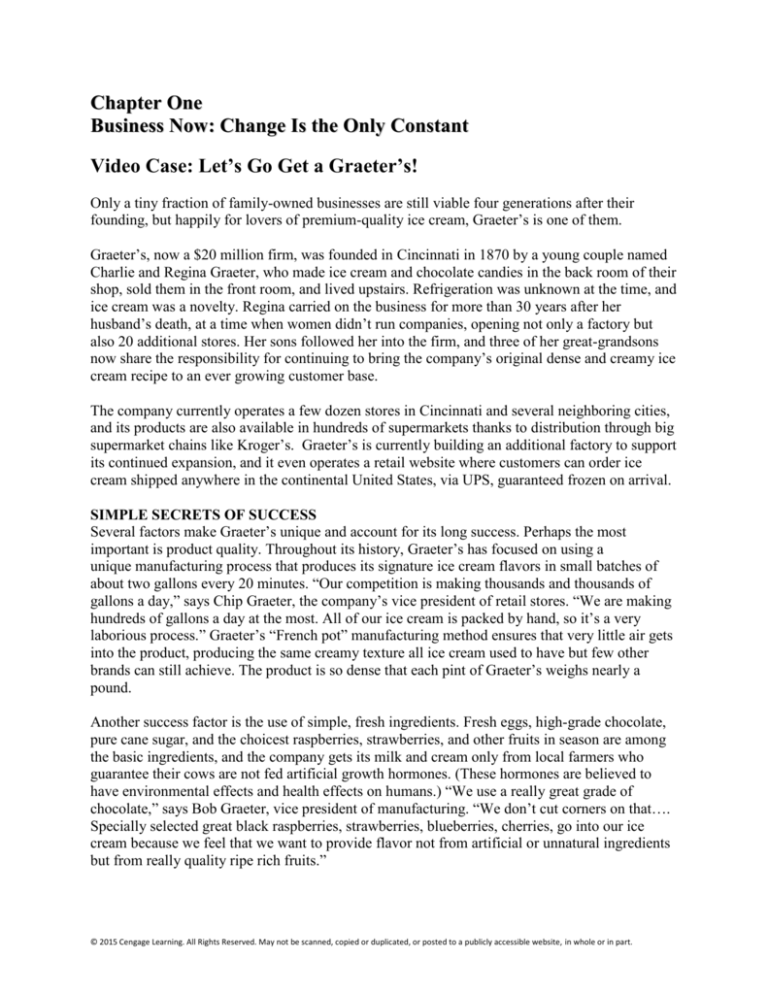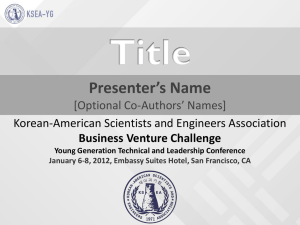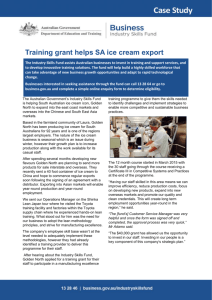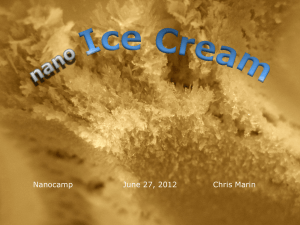
Chapter One
Business Now: Change Is the Only Constant
Video Case: Let’s Go Get a Graeter’s!
Only a tiny fraction of family-owned businesses are still viable four generations after their
founding, but happily for lovers of premium-quality ice cream, Graeter’s is one of them.
Graeter’s, now a $20 million firm, was founded in Cincinnati in 1870 by a young couple named
Charlie and Regina Graeter, who made ice cream and chocolate candies in the back room of their
shop, sold them in the front room, and lived upstairs. Refrigeration was unknown at the time, and
ice cream was a novelty. Regina carried on the business for more than 30 years after her
husband’s death, at a time when women didn’t run companies, opening not only a factory but
also 20 additional stores. Her sons followed her into the firm, and three of her great-grandsons
now share the responsibility for continuing to bring the company’s original dense and creamy ice
cream recipe to an ever growing customer base.
The company currently operates a few dozen stores in Cincinnati and several neighboring cities,
and its products are also available in hundreds of supermarkets thanks to distribution through big
supermarket chains like Kroger’s. Graeter’s is currently building an additional factory to support
its continued expansion, and it even operates a retail website where customers can order ice
cream shipped anywhere in the continental United States, via UPS, guaranteed frozen on arrival.
SIMPLE SECRETS OF SUCCESS
Several factors make Graeter’s unique and account for its long success. Perhaps the most
important is product quality. Throughout its history, Graeter’s has focused on using a
unique manufacturing process that produces its signature ice cream flavors in small batches of
about two gallons every 20 minutes. “Our competition is making thousands and thousands of
gallons a day,” says Chip Graeter, the company’s vice president of retail stores. “We are making
hundreds of gallons a day at the most. All of our ice cream is packed by hand, so it’s a very
laborious process.” Graeter’s “French pot” manufacturing method ensures that very little air gets
into the product, producing the same creamy texture all ice cream used to have but few other
brands can still achieve. The product is so dense that each pint of Graeter’s weighs nearly a
pound.
Another success factor is the use of simple, fresh ingredients. Fresh eggs, high-grade chocolate,
pure cane sugar, and the choicest raspberries, strawberries, and other fruits in season are among
the basic ingredients, and the company gets its milk and cream only from local farmers who
guarantee their cows are not fed artificial growth hormones. (These hormones are believed to
have environmental effects and health effects on humans.) “We use a really great grade of
chocolate,” says Bob Graeter, vice president of manufacturing. “We don’t cut corners on that….
Specially selected great black raspberries, strawberries, blueberries, cherries, go into our ice
cream because we feel that we want to provide flavor not from artificial or unnatural ingredients
but from really quality ripe rich fruits.”
© 2015 Cengage Learning. All Rights Reserved. May not be scanned, copied or duplicated, or posted to a publicly accessible website, in whole or in part.
WELCOMING CHANGE
Finally, while many things about Graeter’s—like its recipes—have stayed simple, its recent
expansion and future growth plans have resulted from something quite new to the firm: outside
advice. The current generation of owners hired management consultants to help them achieve the
kind of productivity increases that allowed for greatly increased capacity so that when Kroger’s,
for instance, suggested expanding Graeter’s to a chain of supermarkets Kroger owns in Denver,
the company could quickly ramp up production to fill the increased orders.
In recent years, change has come quickly to this small firm, which prospered for three prior
generations by staying essentially the same. But, says Bob Graeter, success does require
balancing consistency—what he calls “preserving the core”—with innovation. “If you just
preserve the core,” he says, “ultimately you stagnate. And if you are constantly stimulating
progress and looking for new ideas, well, then you risk losing what was important. . . . Part of
your secret to long-term success is knowing what your core is and holding to that. Once you
know what you’re really all about and what is most important to you, you can change everything
else.” One of those “important” things is giving back to the community and its families via local
charities and other initiatives. Graeter’s recently celebrated a new store opening by making a
cash donation to the local public library, for instance, and has given a research foundation for
pediatric brain cancer the proceeds from sales of a limited-time flavor created by the winner of a
special drawing created for the purpose.
DEFINING THE COMPETITIVE LANDSCAPE
The company recognizes that while it produces a premium product in the ice cream category, its
competition includes offerings other than ice cream. “We would be compared to Ben & Jerry’s
and Haagen Dazs,” says Bob Graeter. “From a sales standpoint and from a shelf-space
allocation, that is how [supermarkets] rank us, but . . . in my opinion that is really not our
competition. Our competition is the upscale treats. It’s like New York Cheesecake. That is our
competition in my opinion. What is it that you are going to have when you want that indulgence,
when you are willing to spend a thousand calories on dessert? It’s going to be something that is
fabulous. Graeter’s in Cincinnati is synonymous with ice cream. People will say, ‘Let’s go get a
Graeter’s.’ They don’t say, ‘Let’s go get an ice cream.’”
Sources” Bob Driehaus, “A Cincinnati Ice Cream Maker Aims Big,” The New York Times,
September 12, 2010, N29; company Web site http://www.graeters.com (accessed September 2,
2010); Alexander Coolridge, “Winburn: Where Is Cincinnati Jobs Retention Plan?”
Cincinnati.com, August 18, 2010, http://news.cincinnati.com; Lucy May, “Graeter’s Northern
Kentucky Franchisee Puts Stores on the Block,” Business Courier, August 6, 2010,
http://cincinnati.bizjournals.com; Ken Hoffman, “Graeter’s Ice Cream Is Worthy Diet Buster,”
The Houston Chronicle, April 15, 2009, http://www.chron.com; Melissa Davis Haller, “The Big
Chill,” Cincinnati Magazine, February 2009, http://www.cincinnatimagazine.com; and
interviews with company staff and the video,“Let’s Go Get a Graeter’s!”
© Cengage Learning
© 2015 Cengage Learning. All Rights Reserved. May not be scanned, copied or duplicated, or posted to a publicly accessible website, in whole or in part.
Critical Thinking Questions
Using information from the case and the video, answer the following questions:
1. Briefly explain how Graeter’s manages to produce a product that is personal to both the
consumer and the company itself.
2. How does Graeter’s emphasize the concept of quality over quantity despite the advent of
mechanization in the ice cream industry?
3. Briefly explain the role the media played in the expansion of Graeter’s as a business.
© 2015 Cengage Learning. All Rights Reserved. May not be scanned, copied or duplicated, or posted to a publicly accessible website, in whole or in part.
Reality TV PPT Clip: Startup Junkies
Earth Class Mail, founded by Ron Wiener, who also is the CEO, discusses the challenges
associated with scaling an operating system so that it can be rapidly ramped up to accommodate
explosive growth in the company’s customer base. Scaling is a process of orchestrating the
development of an operations platform with a large number of moving parts including, but not
limited to, facilities architecture, equipment acquisition and installation, and recruiting and
training of personnel so that all parts evolve together to meet the challenges of a changing
business environment. The Earth Class Mail system is designed to digitize conventional postal
delivery of mail and to support multiple mail processing centers. As such, Earth Class Mail is
particularly appealing to venture capitalists because of the potentially rapid market growth that
can be supported by scalable operations.
© Cengage Learning
What to Watch for and Ask Yourself
1. Which factors of production natural resources, capital, human resources, and
entrepreneurship are especially important for the future success of Earth Class Mail?
Explain why these factors are essential.
2. How do the dimensions of the business environment affect the ability of Earth Class Mail to
rapidly scale up its operations? Explain your answer.
© 2015 Cengage Learning. All Rights Reserved. May not be scanned, copied or duplicated, or posted to a publicly accessible website, in whole or in part.
Lecture Launcher: Urban Farmz - What Do You Mean … This Kind
of Business?
Urban Farmz is not your typical farm. Founders Jake, a MBA graduate, and his free-spirited vegan
cousin, Caleb recently started this organic and sustainable farming cooperative on their grandfather’s
small farm upstate.
As children, Jake and Caleb both grew up in the city and spent their summers at Grandpa Richardson’s
Long Hill Ridge Farm, running through the fields getting dirty. As they got older, their interests changed.
Jake spent time perfecting his golf game and reading the Wall Street Journal. Caleb backpacked around
the world with the earnings from his many business ventures—the burrito stand he set up at outdoor
concerts, his bicycle refurbishing business, converting cars to run on French fry grease, and selling
reclaimed construction materials to green contractors. Recently, Grandpa Richardson announced that he
no longer had the energy to keep the farm going. He’s selling and moving to Florida. Devastated, Jake
and Caleb decide to partner in a new business venture to save the family farm they loved so much as
children.
In this first scenario, we see Jake and Caleb, sitting with their business advisor, Sylvie, and Grandpa
Richardson. Sylvie is presenting the current financial picture of the company after its first six months in
business. So far, things are running well—but there are so many details to worry about.
© Cengage Learning
© 2015 Cengage Learning. All Rights Reserved. May not be scanned, copied or duplicated, or posted to a publicly accessible website, in whole or in part.






